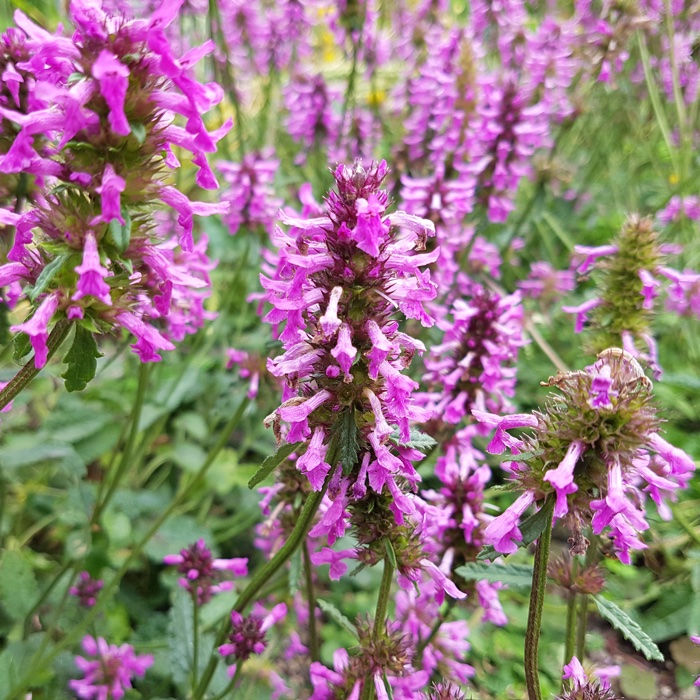
Perennial plant gardens by Piet Oudolf
The Biblioteca degli Alberi park plays host to the extensive work of the great Dutch landscape master Piet Oudolf, who is famous for his gardens boasting a wild appearance. In this park, approximately 20,000 sq.m have been dedicated to his perennial plant gardens for a total of almost 80,000 plants! Perennials, plants with a predominantly herbaceous consistency, long-lived and rapidly developing, are the basis of his work, whether they are grasses or blooms. The technique that Oudolf used was that of the matrix, a single large mass of basic graminaceous plants (Molinia caerulea ‘Dauerstrah’ in this case), in which large monospecific perennial bushes of organic shapes that resemble each other and that interpenetrate are inserted, alternating spectacular bright blooms throughout the year. Some of these plants are evergreen while many others are deciduous, but retain the aerial part even in cold or dry periods, as important value considered in Oudolf creations. The compositions thus created offer catching theatrical effects with marked energy and beautiful aesthetic effects. Piet Oudolf, author of the New York High Line and numerous gardens around the world, is the world’s most famous landscape designer.
n° plants: 76.020
surface area: 20.270 mq
SPECIES LIST
Perennial herbaceous plants:
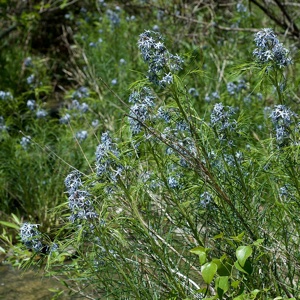 Amsonia hubrichtii – Apocynaceae Bushy, erect perennial plant with light green leaves that are so thin as to almost seem acerose, which turn a beautiful golden-copper colour during the fall. Small blue flowerets appear in June and July.
Amsonia hubrichtii – Apocynaceae Bushy, erect perennial plant with light green leaves that are so thin as to almost seem acerose, which turn a beautiful golden-copper colour during the fall. Small blue flowerets appear in June and July.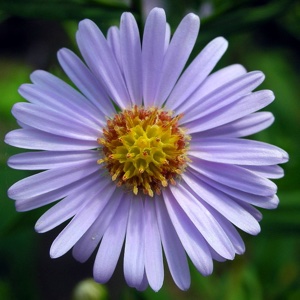 Aster tataricus ‘Jindai’ – Asteraceae Perennial plant with an upright bearing, this Aster can reach 150 cm in height, has medium-small purple-sky blue flowers similar to daisies that appear at the height of fall between October and November.
Aster tataricus ‘Jindai’ – Asteraceae Perennial plant with an upright bearing, this Aster can reach 150 cm in height, has medium-small purple-sky blue flowers similar to daisies that appear at the height of fall between October and November.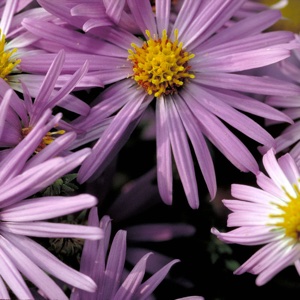 Aster oblongifolius ’October Skies’ – Asteraceae Bushy, compact and drought-resistant perennial plant. Its abundant flowering with large lavender-coloured daisies during the fall is useful for attracting and feeding pollinating insects such as butterflies and bees.
Aster oblongifolius ’October Skies’ – Asteraceae Bushy, compact and drought-resistant perennial plant. Its abundant flowering with large lavender-coloured daisies during the fall is useful for attracting and feeding pollinating insects such as butterflies and bees.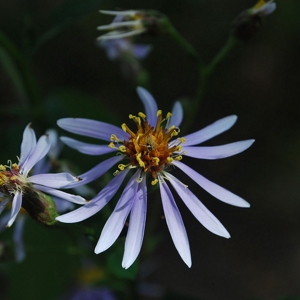 Aster macrophyllus ‘Twilight’ Rustic, vigorous perennial plant with many branches, it boasts a lovely dark green foliage. It is one of the first Asters to bloom. It is covered with a profusion of large flowers that look like daisies blue-lavender in colour from July to the end of September.
Aster macrophyllus ‘Twilight’ Rustic, vigorous perennial plant with many branches, it boasts a lovely dark green foliage. It is one of the first Asters to bloom. It is covered with a profusion of large flowers that look like daisies blue-lavender in colour from July to the end of September.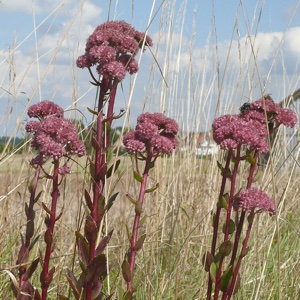 Sedum telephium ‘Matrona’ – Crassulaceae Rustic perennial featuring purple stalks, large fleshy and succulent leaves that are green with greyish reflections, which change colour to become violet-purple. It produces small, highly ornamental star-shaped pale pink flowers between August and October.
Sedum telephium ‘Matrona’ – Crassulaceae Rustic perennial featuring purple stalks, large fleshy and succulent leaves that are green with greyish reflections, which change colour to become violet-purple. It produces small, highly ornamental star-shaped pale pink flowers between August and October.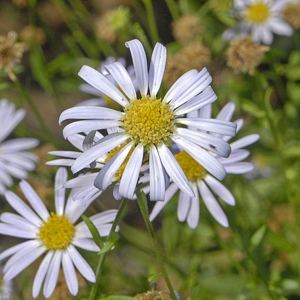 Kalimeris incisa – Asteraceae Perennial plant with an upright and spread out bearing, with rigid stalks having many branches and light green lanceolate and dentate leaves. It blooms abundantly with violet/pale pink flowers having a yellow centre, similar to the classic daisies, between August and September.
Kalimeris incisa – Asteraceae Perennial plant with an upright and spread out bearing, with rigid stalks having many branches and light green lanceolate and dentate leaves. It blooms abundantly with violet/pale pink flowers having a yellow centre, similar to the classic daisies, between August and September.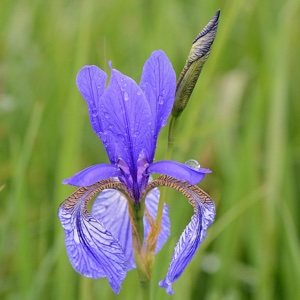 Iris sibirica ‘Perry’s Blue’ – Iridaceae Perennial up to 70 cm tall with narrow green and long lanceolate leaves. It produces large sky blue flowers with white markings having the classic Iris shape between June and July. Its roots are underground rhizomes that allow this plant to store resources and produce new plants.
Iris sibirica ‘Perry’s Blue’ – Iridaceae Perennial up to 70 cm tall with narrow green and long lanceolate leaves. It produces large sky blue flowers with white markings having the classic Iris shape between June and July. Its roots are underground rhizomes that allow this plant to store resources and produce new plants.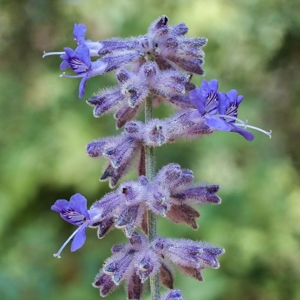 Perovskia atriplicifolia ‘Little Spire’ – Lamiaceae Shrubby perennial distinguished by a compact bearing, aromatic green-silver foliage and a lengthy flowering with panicle inflorescences formed by numerous blue-lavender flowerets between August and October.
Perovskia atriplicifolia ‘Little Spire’ – Lamiaceae Shrubby perennial distinguished by a compact bearing, aromatic green-silver foliage and a lengthy flowering with panicle inflorescences formed by numerous blue-lavender flowerets between August and October.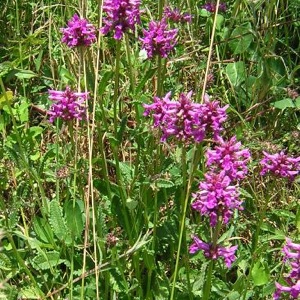 Stachys officinalis ‘Hummelo’ – Lamiaceae Perennial plant with veritical stalks on whose tips dense flowering of pink-purple flowers that bees and butterflies love appears between June and September. It is a cultivar that takes its name from the Dutch village where the master Piet Oudolf developed his famous experimental gardent.
Stachys officinalis ‘Hummelo’ – Lamiaceae Perennial plant with veritical stalks on whose tips dense flowering of pink-purple flowers that bees and butterflies love appears between June and September. It is a cultivar that takes its name from the Dutch village where the master Piet Oudolf developed his famous experimental gardent.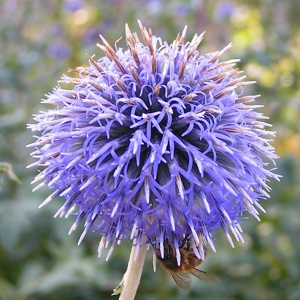 Echinops bannaticus ‘Taplow Blue’ – Asteraceae Rustic perennial herbaceous plant with an unusual summer flowering, as tall as even 100 cm, made up of a multitude of balls of sky blue-lilac flowers that stream over the plant from July to October and remain dry all winter.
Echinops bannaticus ‘Taplow Blue’ – Asteraceae Rustic perennial herbaceous plant with an unusual summer flowering, as tall as even 100 cm, made up of a multitude of balls of sky blue-lilac flowers that stream over the plant from July to October and remain dry all winter. Geranium hybridum ‘Patricia’ – Geraniaceae Strong, long-living and vigorous perennial plant with beautiful palmate leaves and magenta-purple flower, with brown-blackish centres and streaks. Its showy flowers appear between May and August.
Geranium hybridum ‘Patricia’ – Geraniaceae Strong, long-living and vigorous perennial plant with beautiful palmate leaves and magenta-purple flower, with brown-blackish centres and streaks. Its showy flowers appear between May and August.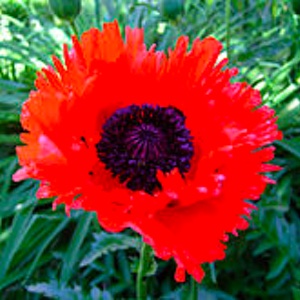 Papaver orientale ‘Scarlett O’Hara’ – Papaveraceae Poppies about 50 cm tall with small tufts of finely tomentose dark green leaves. The showy corollas appear in late spring and early summer. This variety is characterised by semi-double flowers of a marvellous scarlet red with the characteristic black centre.caratteristico centro nero.
Papaver orientale ‘Scarlett O’Hara’ – Papaveraceae Poppies about 50 cm tall with small tufts of finely tomentose dark green leaves. The showy corollas appear in late spring and early summer. This variety is characterised by semi-double flowers of a marvellous scarlet red with the characteristic black centre.caratteristico centro nero.
Poaceae (Graminacee)
 Molinia caerulea ‘Dauerstrah’ Graminaceous plant with emerald green foliage, made up of rigid stalks on which elegant panicles formed by thin brown-dark violet spikes. In the fall, the fine foliage is distinguished by switching to beautiful and enduring bright yellow-gold shades.
Molinia caerulea ‘Dauerstrah’ Graminaceous plant with emerald green foliage, made up of rigid stalks on which elegant panicles formed by thin brown-dark violet spikes. In the fall, the fine foliage is distinguished by switching to beautiful and enduring bright yellow-gold shades.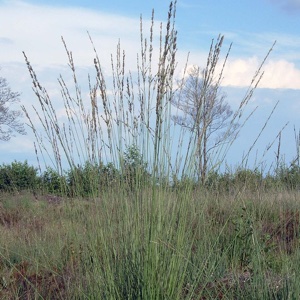 Molinia caerulea ‘Strahlenquelle’ Graminaceous plant 120-150 cm tall with stalks of a marvellous fall shade of yellow-golden and then orange-bronze and many purple-violet inflorescenes that appear between July and September. As its dry and golden stalks remain upright, its beauty continues in the winter as well.
Molinia caerulea ‘Strahlenquelle’ Graminaceous plant 120-150 cm tall with stalks of a marvellous fall shade of yellow-golden and then orange-bronze and many purple-violet inflorescenes that appear between July and September. As its dry and golden stalks remain upright, its beauty continues in the winter as well.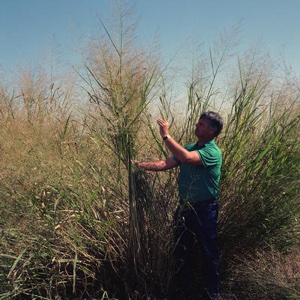 Panicum virgatum ‘Cloud Nine’ Graminaceous plant that tolerates barren and dry soils, with a splendid grey-green vegetation up to 200-250 cm in height, iridescent in a deep gold colour in the fall. The airy, wavy inflorescences that are also attractive in the winter appear from August to October. As they take in the sunlight, they are filled with light.
Panicum virgatum ‘Cloud Nine’ Graminaceous plant that tolerates barren and dry soils, with a splendid grey-green vegetation up to 200-250 cm in height, iridescent in a deep gold colour in the fall. The airy, wavy inflorescences that are also attractive in the winter appear from August to October. As they take in the sunlight, they are filled with light. Panicum virgatum ‘Shenandoah’ Perennial graminaceous plant that can exceed 120 cm in height and that feature upright, cylindrical stalks with reddish green leaves and a highly evident central nervation. Purple-pink panicle-shaped inflorescences appear toward the end of the summer, which are attractive in the winter as well.
Panicum virgatum ‘Shenandoah’ Perennial graminaceous plant that can exceed 120 cm in height and that feature upright, cylindrical stalks with reddish green leaves and a highly evident central nervation. Purple-pink panicle-shaped inflorescences appear toward the end of the summer, which are attractive in the winter as well.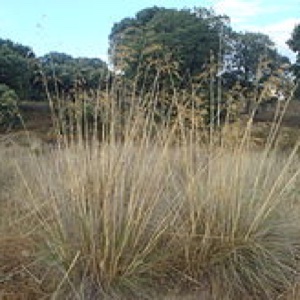 Stipa gigantea – Poaceae Perennial graminaceous plant with a light bearing and stems that turn from green to golden in the winter. It loves dry and well-drained soils, has classic spikes in large yellow-golden panicles that stand out against the green tufts of leaves between June and August.giallo-dorate, che si stagliano dal verde cespo di foglie tra giugno e agosto.
Stipa gigantea – Poaceae Perennial graminaceous plant with a light bearing and stems that turn from green to golden in the winter. It loves dry and well-drained soils, has classic spikes in large yellow-golden panicles that stand out against the green tufts of leaves between June and August.giallo-dorate, che si stagliano dal verde cespo di foglie tra giugno e agosto. Spodiopogon sibiricus – Poaceae Plant with an upright bearing, slender vertical leaves blue-green in colour that turn to an iridescent yellow-orange in the fall. The stems, topped by feathery brown-golden inflorescences, rise up well above the tuft of foliage toward the end of the summer, in this way capturing and reflecting the sunlight in a very characteristic manner.
Spodiopogon sibiricus – Poaceae Plant with an upright bearing, slender vertical leaves blue-green in colour that turn to an iridescent yellow-orange in the fall. The stems, topped by feathery brown-golden inflorescences, rise up well above the tuft of foliage toward the end of the summer, in this way capturing and reflecting the sunlight in a very characteristic manner.
Botanical information powered by AG&P
See on the map

